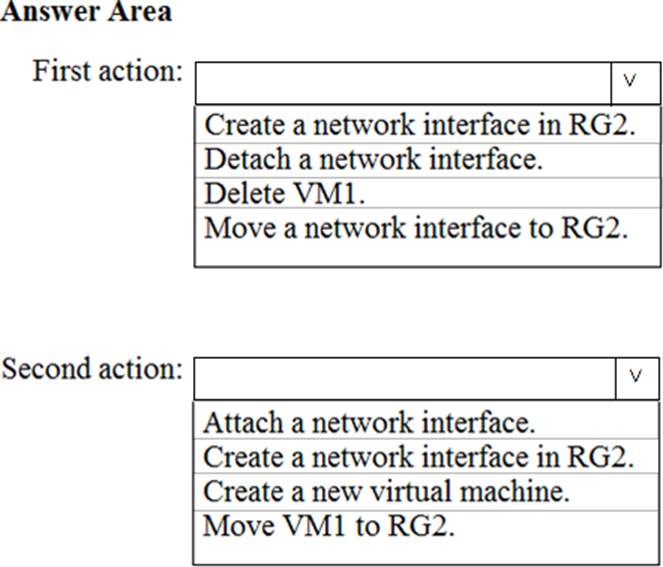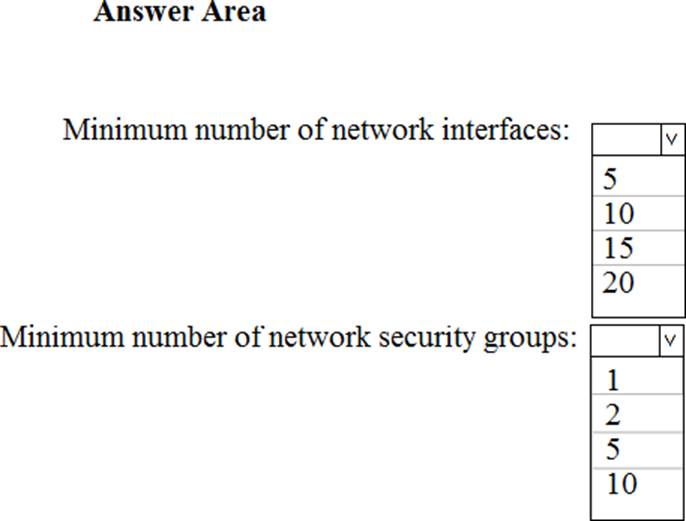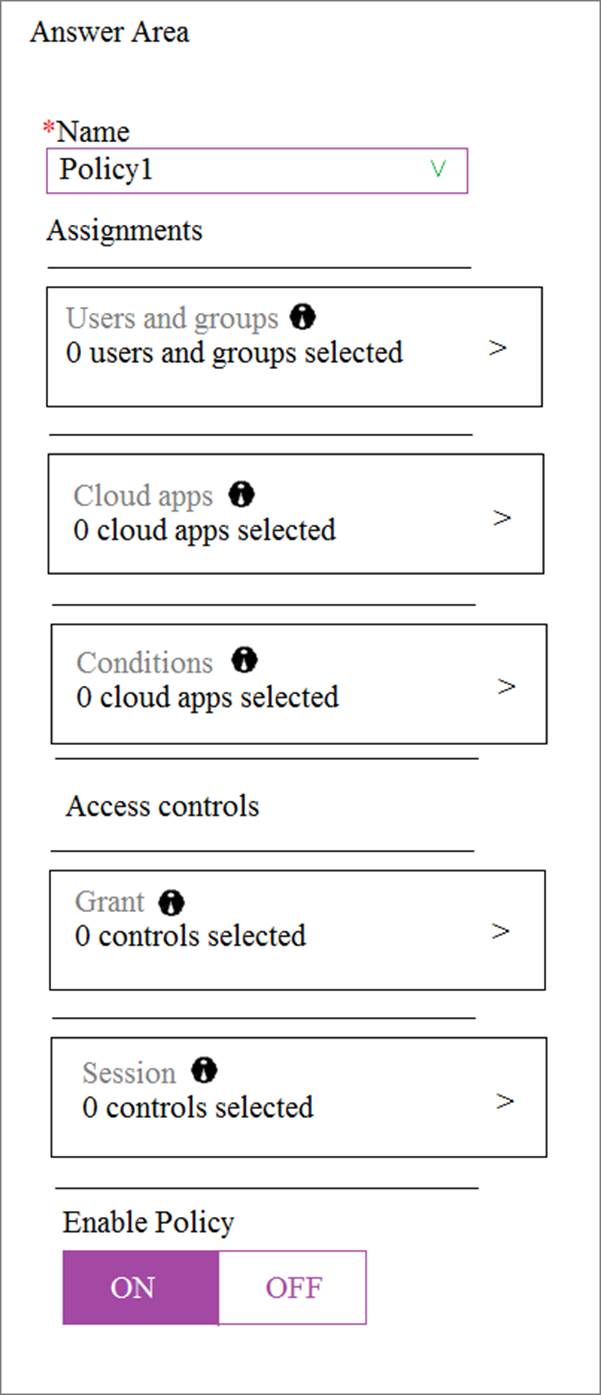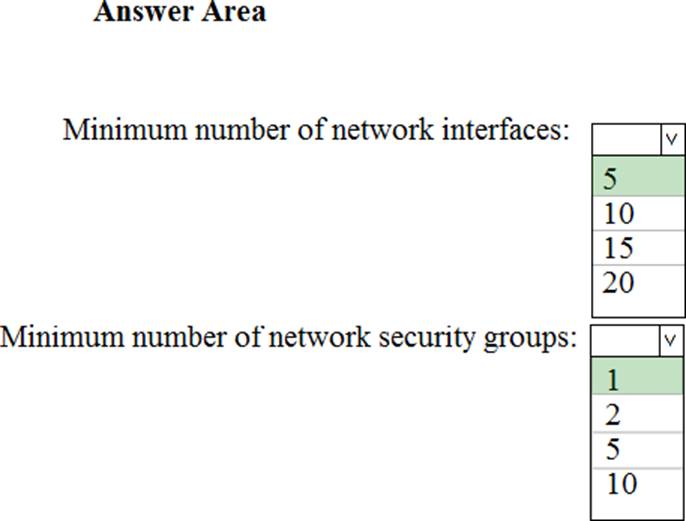Microsoft AZ-300 Microsoft Azure Architect Technologies Online Training
Microsoft AZ-300 Online Training
The questions for AZ-300 were last updated at Jan 05,2026.
- Exam Code: AZ-300
- Exam Name: Microsoft Azure Architect Technologies
- Certification Provider: Microsoft
- Latest update: Jan 05,2026
Question Set 1
HOTSPOT
You have an Azure subscription named Subscription1.
Subscription1 contains the resources in the following table:

VNet1 is in RG1. VNet2 is in RG2. There is no connectivity between VNet1 and VNet2. An administrator named Admin1 creates an Azure virtual machine VM1 in RG1. VM1 uses a disk named Disk1 and connects to VNet1. Admin1 then installs a custom application in VM1.
You need to move the custom application to VNet2. The solution must minimize administrative effort.
Which two actions should you perform? To answer, select the appropriate options in the answer area. NOTE: Each correct selection is worth one point.

You have an Azure subscription named Subscription1 that is used by several departments at your company.
Subscription1 contains the resources in the following table.

Another administrator deploys a virtual machine named VM1 and an Azure Storage account named Storage2 by using a single Azure Resource Manager template. You need to view the template used for the deployment.
From the Azure Portal, for which blade can you view the template that was used for the deployment?
- A . Container1
- B . VM1
- C . Storage2
- D . RG1
You have two subscriptions named Subscription1 and Subscription2. Each subscription is associated to a different Azure AD tenant. Subscription1 contains a virtual network named VNet1. VNet1 contains an Azure virtual machine named VM1 and has an IP address space of 10.0.0.0/16.
Subscription2 contains a virtual network named VNet2. Vnet2 contains an Azure virtual machine named VM2 and has an IP address space of 10.10.0.0/24. You need to connect VNet1 to VNet2.
What should you do first?
- A . Modify the IP address space of VNet2.
- B . Move VM1 to Subscription2.
- C . Provision virtual network gateways.
- D . Move VNet1 to Subscription2.
You have an Azure Active Directory (Azure AD) tenant.
You have an existing Azure AD conditional access policy named Policy1. Policy1 enforces the use of Azure AD-joined devices when members of the Global Administrators group authenticate to Azure AD from untrusted locations.
You need to ensure that members of the Global Administrators group will also be forced to use multi-factor authentication when authenticating from untrusted locations.
What should you do?
- A . From the Azure portal, modify session control of Policy1.
- B . From multi-factor authentication page, modify the user settings.
- C . From multi-factor authentication page, modify the service settings.
- D . From the Azure portal, modify grant control of Policy1.
HOTSPOT
You plan to deploy five virtual machines to a virtual network subnet. Each virtual machine will have a public IP address and a private IP address. Each virtual machine requires the same inbound and outbound security rules.
What is the minimum number of network interfaces and network security groups that you require? To answer, select the appropriate options in the answer area. NOTE: Each correct selection is worth one point.

You have an Azure subscription named Subscription1 that contains an Azure virtual machine named VM1. VM1 is in a resource group named RG1.
VM1 runs services that will be used to deploy resources to RG1.
You need to ensure that a service running on VM1 can manage the resources in RG1 by using the identity of VM1.
What should you do first?
- A . From the Azure portal, modify the Access control (IAM) settings of RG1.
- B . From the Azure portal, modify the Policies settings of RG1.
- C . From the Azure portal, modify the Access control (IAM) settings of VM1.
- D . From the Azure portal, modify the value of the Managed Service Identity option for VM1.
HOTSPOT
You have an Azure subscription named Subscription1.
Subscription1 contains the virtual networks in the following table:

Subscription1 contains the virtual machines in the following table:

The firewalls on all the virtual machines are configured to allow all ICMP traffic.
You add the peerings in the following table:

For each of the following statements, select Yes if the statement is true. Otherwise, select No. NOTE: Each correct selection is worth one point.

HOTSPOT
You have an Azure Active Directory (Azure AD) tenant.
You need to create a conditional access policy that requires all users to use multi-factor authentication when they access the Azure portal.
Which three settings should you configure? To answer, select the appropriate settings in the answer area. NOTE: Each correct selection is worth one point.

You configure Azure AD Connect for Azure Active Directory Seamless Single Sign-On (Azure AD Seamless SSO) for an on-premises network. Users report that when they attempt to access myapps.microsoft.com, they are prompted multiple times to sign in and are forced to use an account name that ends with onmicrosoft.com.
You discover that there is a UPN mismatch between Azure AD and the on-premises Active Directory. You need to ensure that the users can use single-sign on (SSO) to access Azure resources.
What should you do first?
- A . From on-premises network, deploy Active Directory Federation Services (AD FS).
- B . From Azure AD, add and verify a custom domain name.
- C . From on-premises network, request a new certificate that contains the Active Directory domain name.
- D . From the server that runs Azure AD Connect, modify the filtering options.
You have an Active Directory forest named contoso.com.
You install and configure Azure AD Connect to use password hash synchronization as the single sign-on (SSO) method. Staging mode is enabled. You review the synchronization results and discover that the Synchronization Service Manager does not display any sync jobs. You need to ensure that the synchronization completes successfully.
What should you do?
- A . From Azure PowerShell, run Start-AdSyncSyncCycle CPolicyType Initial.
- B . Run Azure AD Connect and set the SSO method to Pass-through Authentication.
- C . From Synchronization Service Manager, run a full import.
- D . Run Azure AD Connect and disable staging mode.
Latest AZ-300 Dumps Valid Version with 283 Q&As
Latest And Valid Q&A | Instant Download | Once Fail, Full Refund





